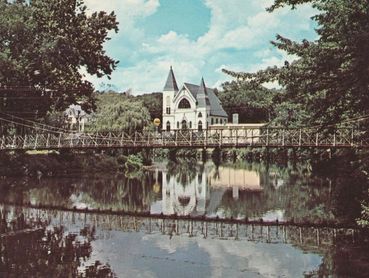Milford History Online
The Swing Bridge
In the October 9, 1975 edition of the Milford Cabinet, the “Rambling Reporter” column relates the following encounter on Milford’s historic Swing Bridge between a young boy and an older lady. Speeding down the bridge on his bike, the boy stopped short and apologized. “Sorry, I didn’t mean to scare you.” Getting off his ride, he explained: “We aren’t allowed to ride bikes on the bridge.” The woman was not disturbed. “Young man, put the bike against the railing and let’s have some fun. When I was a little girl, I used to walk across this bridge every day to school. We used to bounce on the middle and scare the old ladies.” Indeed, Milford pedestrians have now been making the most of this delightful, out-of-the-way bridge for 125 years — jumping, bouncing, fishing, meditating, riding bikes — even sending across the occasional Volkswagen. Perhaps no other local landmark has had quite so much fun.
Despite its resplendent charm, the Swing Bridge is also a bit of an odd duck. For instance, there’s its location. For those living in the Souhegan Street neighborhood, the bridge offers a handy way to walk downtown. For everyone else, however, the crossing may seem a wee bit random. If you start at the end of Bridge Street behind the fire station, it deposits you across the river rather unceremoniously into a residential neighborhood. However, a little history provides the bridge’s location with more logic, as one considers that in the days before automobiles, factory workers at the big French & Heald plant (located where the Granite Square apartments now stand) and the McLane Furniture Factory (located where Cumberland Farms now stands) crossed the bridge daily from housing on the east side of town to get to work at the mills.
But what about that name? Bridge bouncing might give the old ladies a fright, but swinging? Turns out the name comes from some precarious predecessors. The original swing bridge went up about 1850 and crossed the Souhegan a little downriver. Never a sturdy affair, it had some serious swinging moments — in fact, during an icy 1857 storm, a woman was swept off the bridge and drowned. That original bridge was taken down and its replacement, in the vicinity of the current bridge, was washed away in a storm. Today’s 200-foot iron suspension bridge, with its durable steel cables and nearly three-story-tall uprights, was constructed in 1889 by the Berlin Iron Bridge Company of Connecticut for $3500. The firm gave it both beauty and brawn – the Victorian-era ironwork complete with finials and lattice girders speaks to the ornamental era in which it was built. Since then, a century and more of mill workers, joggers, dog-walkers, and deep thinkers have enjoyed the lovely view towards St. Patrick’s in one direction and towards the McLane Dam in the other.
The Swing Bridge, however, has certainly seen better days. Perhaps all those forbidden bike rides and frolicking bouncers have caught up to it but, as its last makeover came during Milford’s 1975 bicentennial celebration, the Swing Bridge is now suffering from bent trusses, severed wires, and peeling paint. When an engineering firm issued a report on the bridge’s safety in 2015, it received a poor grade and a life expectancy of five to ten years. Since then, there has been an unsuccessful push to include it on the NH Preservation Alliance’s “Seven to Save” and a successful bid to place it on the National Register of Historic Places. Today, the bridge is thankfully on NHDOT’s Ten Year Transportation Improvement Plan and according to Milford’s website, the rehabilitation “is fully funded and slated for engineering and construction in 2024.” It seems the old bridge may have a few swings left in it yet.


Above: Two early postcards of Milford's Swing Bridge. (Courtesy MHS)
This website uses cookies.
We use cookies to analyze website traffic and optimize your website experience. By accepting our use of cookies, your data will be aggregated with all other user data.